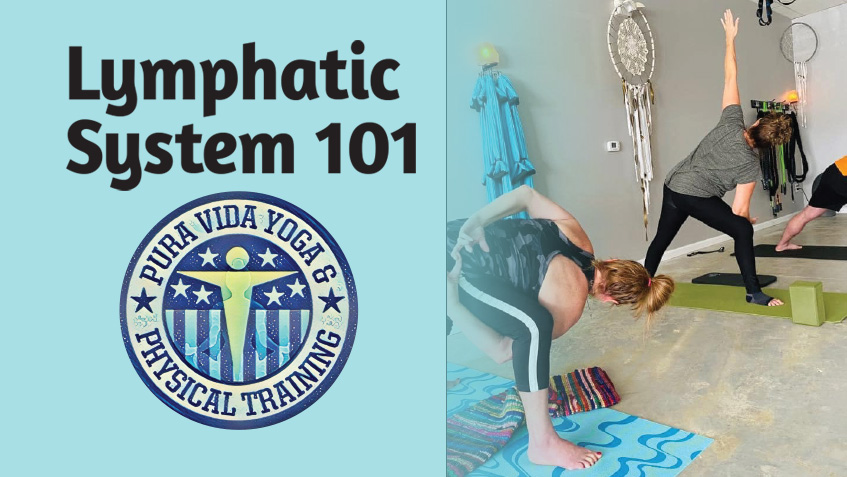By: Rebecca Hummer of Pura Vida Yoga & Physical Training in Maryland
The lymphatic system, or lymphoid system, is an organ system that is part of the immune system, and complementary to the circulatory system. It consists of a large network of lymphatic vessels, lymph nodes, lymphoid organs, lymphoid tissues and lymph. Lymph is a clear fluid carried by the lymphatic vessels back to the heart for re-circulation. (The Latin word for lymph, lympha, refers to the deity of fresh water, “Lympha”). One of the main functions of the lymphatic system is to provide an accessory return route to the blood for the surplus. The other main function is that of immune defense.What are the symptoms of a poor lymphatic system?
Symptoms of lymphoedema:
• an aching, heavy feeling.
• difficulty with movement.
• repeated skin infections.
• the skin becoming hard and tight.
• folds developing in the skin
• a leakage of fluid through the skin.
The build-up of fluid in the tissues of people with lymphoedema may be a sign they are more vulnerable to infection. A bacterial infection of the skin called cellulitis is common in people with the condition.
There are two main types of lymphoedema:
• Primary lymphoedema: caused by faulty genes affecting the development of the lymphatic system; it can develop at any age, but usually occurs in early adulthood.
• Secondary lymphoedema: caused by damage to the lymphatic system or problems with the movement and drainage of fluid in the lymphatic system, often due to an infection, injury, cancer treatment, inflammation of the limb or a lack of limb movement.
How do you detox your lymphatic system?
Regular physical exercise is a key tool to get your lymphatic system pumping and detoxing your system of waste. Jumping, dancing, walking, stretching, YOGA, and other moderate exercises done on a daily basis will improve the state of your lymph. Wearing compression garments, tending to your your skin, having a healthy diet and lifestyle, and using manual or simple massage techniques help.
There are two types of lymphatic drainage:
• Manual: A qualified therapist will perform manual lymphatic drainage.
• Simple: Simple lymphatic drainage is a technique a person can use at home.
However, this type of massage may not be suitable or safe for some people, for example, if they have cellulitis or a heart condition. People should speak with a doctor before using lymphatic massage.
What are the benefits of lymphatic drainage massage?
• Debloats and depuffs.
• Breaks down cellulite and fat cells.
• Gives skin a glow.
• Helps with post-injury swelling.
• Eases tension in the body.
Lymphatic breathing is a tool! Deep breathing acts like a pump that helps move fluid through the vessels and lymph nodes. Follow the steps below:
1. Place both hands on the ribs.
2. Take slow, deep breaths and feel the air
move down to the abdomen.
3. Slowly sigh the air out through the mouth.
4. Rest between breaths and repeat five times.
Simple Lymphatic Massage for front/sides of the neck and chest:
1. Place the index and middle fingers of each hand on either side of the neck, just below the earlobe.
2. Stretch the skin by gently sliding the fingers down toward the shoulders, then release.
3. Repeat 10–15 times.
4. Move the hands down and repeat until you have massaged the whole neck.
Place the palm flat on the opposite side of the chest, slightly above the breast:
1. Move the hand up the chest and over the collarbone.
2. Continue up the neck until the skin covering the chest feels tight, then release.
Under the arms and fingers: Prepare the lymph nodes under the arms to help them accept lymph fluid from other areas.
1. Cup the palm under the armpit.
2. Gently pump the palm upward and toward the body.
3. Repeat on the other arm.
To massage the fingers:
1. Start at the base of the swollen finger close to the palm.
2. Use the index finger and thumb to stretch the skin on the finger toward the hand.
3. Continue this motion over the entire finger.
4. Remember to direct fluid toward the hand.
Behind the knees and toes:
1. Place both hands behind the knee so the fingers point toward each other.
2. Pump the back of the knee by gently pressing the hands into the back of the knee and rolling them upward.
3. Repeat on the other knee.
To massage the toes:
Use the thumb and index finger and stroke the skin from the tip of each toe toward the base.
It is vital to always end the massage by drinking extra fluids. People should use light pressure during the massage and avoid any areas with swelling. People who think that they could benefit from a lymphatic drainage massage should speak with a primary care or physical therapist, preferably one who specializes in treating lymphedema.
Utilizing these tools may assist in the health of and/or improve circulation throughout the lymphatic system and aid with lymphedema.
Explore more articles from VOM Magazine here: https://www.veteransoutreachministries.org/vom-magazine/




